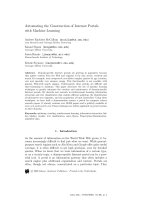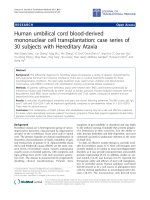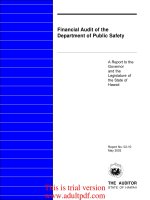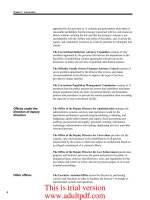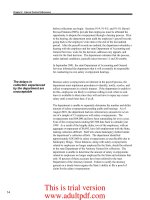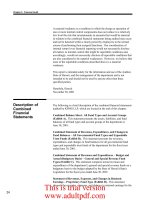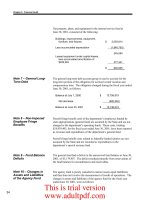FINANCIAL AUDIT Issues Regarding Reconciliations of Fund Balances With Treasury Accounts doc
Bạn đang xem bản rút gọn của tài liệu. Xem và tải ngay bản đầy đủ của tài liệu tại đây (754.96 KB, 15 trang )
JAO
)
Report
to
the
Secretary
of
the
'lreasuly
September
1999
FINANCIAL
AUDIT
Issues
Regarding
Reconciliations
of
Fund
Balances
With
Treasury
Accounts
:
G
A
O
GAO/AIMD-99-27
1
This is trial version
www.adultpdf.com
-
AGAO
.Accountability
*
Integrity
*
Rellability
United
States
General
Accounting
Office
Accounting
and
Information
Washington,
D.C.
20548
Management
Division
B-283392
September
17,
1999
The
Honorable
Lawrence
H.
Summers
The
Secretary
of
the
Treasury
Dear
Mr.
Secretary:
Reconciliations
of
federal
agencies'
Fund
Balances
with
Treasury
accounts
continue
to
be
a
significant
problem
contributing
to
our
inability
to
render
an
opinion
on
the
U.S.
government's
fiscal
year
1998
financial
statements.
In
our
March
1999
audit
report
on
the
1998
Financial
Report
of
the
United
States
Government,
we
reported
that
several
major
agencies
were
not
effectively
reconciling
cash
disbursements.
We
also
reported
that
there
continued
to
be
billions
of
dollars
of
unresolved
gross
differences
between
agencies'
and
the
Department
of
the
Treasury's
records
of cash
disbursements
as
of
September
30,
1998.
We
previously
reported
similar
problems
for
fiscal
year
1997.2
Federal
agencies
record
their
budget
spending
authorization
in
Fund
Balances
with
Treasury
accounts,
and
increase
or
decrease
these
accounts
as
they
collect
or
disburse
funds.
Treasury
designed
various
procedures
and
controls-called
the
reconciliation
process-aimed
primarily
at
ensuring
the
reliability
of
receipt
and
disbursement
data
reported
by
agencies.
This
monthly
reconciliation
process-similar
in
concept
to
individuals
reconciling
personal
checkbooks
with
a
bank's
records
each
month-is
intended
to
be
a
key
internal
control
over
the
federal
receipts
and
disbursements
that
flow
through
these
accounts.
As
part
of
our
audit
of
the
U.S.
government's
fiscal
year
1998
financial
statements,
we
continued
our
efforts
to
monitor
and
evaluate
the
overall
effectiveness
of
agencies'
reconciliation
processes
for
Fund
Balances
with
Treasury
accounts.
In
addition,
we
followed
up
on
Treasury's
actions
to
improve
its
assistance
to
agencies
in
their
reconciliation
efforts.
This
report
provides
the
results
of
that
work.
'Financial
Audit:
1998
Financial
Report
of
the
United
States
Government
(GAO/AIMD-99-130,
March
31,1999).
'Financial
Audit:
1997
Consolidated
Financial
Statements
of
the
United
States
Government
(GAO/AIMD-98-127,
March
31,
1998)
and Financial
Audit:
Issues
Regarding
Reconciliations
of
Fund
Balances
with
Treasury
Accounts
(GAO/AIMD-99-3,
October
14,
1998).
Page
1
GAO/AIMD-99-271
Agency
Reconciliations
of
Fund
Balances
This is trial version
www.adultpdf.com
B-283392
Results
in
Brief
Auditors
continued
to
find
significant
problems
with
federal
agencies'
reconciliations
of
Fund Balances
with
Treasury
accounts
in
fiscal year
1998.
3
Auditors
reported
reconciliation problems
at
11
federal
agencies
covered
by
the
Chief
Financial
Officers
Act
of
1990
(CFO
Act).
4
These
agencies
disbursed
about
48
percent
of the
total
federal
dollars
disbursed
in
fiscal
year
1998
and
had
billions of
dollars
in
unreconciled
differences
outstanding
at
year-end.
These agencies
were
either not
timely
in
reconciling
their
Fund
Balances
with
Treasury
accounts
or
were
adjusting
their
accounts
to
match
the
amounts
reported
by Treasury.
These
adjustments were
made
without
adequately
researching
the causes
of the
differences and
thus without
knowing
which
number,
if
any,
was
correct.
Auditors
reported
that
the
lack of
effective
internal
control
procedures
was,
in
general,
the
underlying
cause of
agency
reconciliation problems.
Auditors
also
reported
that
improper
reconciliations
contributed
to
management
not
detecting
certain instances
of fraud
and
mismanagement
of
funds
at
two
agencies.
We
reported
that
ineffective
cash
disbursement
reconciliations
affect
the
reliability
of
the
U.S.
government's
fiscal
year
1998
financial
statements
and
the
underlying financial
information.
We
also
reported
that
the
failure
of
certain
agencies
to
properly
reconcile
their
disbursements increases
the
risks of inaccuracies
in
the
President's
budget
and
contributes
to
the
overall
inability
of
the
federal
government
to
accurately
measure the
full
cost
of
its programs.
Agencies
depend
on
Treasury
for
support
in
fulfilling
their
reconciliation
responsibilities.
Treasury
has
taken
steps
to
improve
its
assistance
to
agencies
in
performing
their
reconciliation
processes, such
as providing
more
detailed
reports
to
agencies and
developing
supplemental
written
guidance
and training
courses
for
agencies.
However,
because
of
the
timing
and
nature
of
these
actions,
at
the
end of
our
field
work
for
the
audit of the
U.S.
government's
fiscal
year
1998
financial
statements,
it
was
too
early
to
3The
fiscal
year
1998
audits
were
performed
by
auditors
from
the
Offices
of
the
Inspectors
General
(OIG),
or Independent
Public
Accounting
firms
under
contract
with the
OIGs,
or
by
us.
4
The
CFO Act,
as
expanded
by
the
Government
Management
Reform
Act
of
1994,
requires the
issuance
of
annual
audited
financial
statements
for
the
24
executive
agencies
specified
in
the
law.
However,
the
audit
reports
fbr
four
of
the
agencies
covered
by
the
CFO
Act
were
not
issued
in
time for
us to
include
their
results
in
this report.
When
we
refer
to
agencies
in
this
report,
we
are
referring
to
the
agencies
covered
by
the
CFO
Act.
Page
2
GAO/AIMD-99-271
Agency
Reconciliations
of
Fund
Balances
This is trial version
www.adultpdf.com
B-283392
assess
the
impact
such
actions
had
on
improving
the
overall
effectiveness
of
agencies'
reconciliations
of
Fund
Balances
with
Treasury
accounts.
Background
We
first
reported
on
agencies'
long-standing
reconciliation
problems
during
our
preparation
for
the
audit
of
the
U.S.
government's
fiscal
year
1997
financial
statements.
At
that
time,
we
issued
a
letter
dated
June
24,
1997,
to
alert
agency
Inspectors
General
and
Chief
Financial
Officers
of
our
concerns
about
large
unreconciled
differences
and
improper
agency
adjustments.
5
However,
as
indicated
in
our
report
on
the
audit
of
the
U.S.
government's
fiscal
year
1997
financial
statements,
several
major
agencies
were
not
effectively
reconciling
their
records
with
Treasury's
records
of
cash
disbursements.
Thus,
agency
reconciliation
problems,
one
of
several
material
deficiencies
included
in
our
March
1998
report,
contributed
to
our
inability
to
render
an
opinion
on
those
financial
statements.
Further,
we
issued
a
report
in
October
1998
which
presented
a more
in-depth
analysis
of
the
agency
reconciliation
problems
identified
in
our
fiscal
year
1997
audit
and
recommended
ways
for
Treasury
to
enhance
its
assistance
to
agencies
to
help
them
fulfill
their
responsibility
to
timely
and
properly
reconcile
Fund
Balances
with
Treasury
accounts.
Because
most
assets,
liabilities,
revenues,
and
expenses
stem
from
or
result
in
cash
transactions,
errors
in
the
receipt
or
disbursement
data
affect
the
accuracy
of
the
individual
agency
financial
reports
and
various
U.S.
government
financial
reports,
including
data
provided
by
agencies
for
inclusion
in
the
President's
budget
concerning
fiscal
year
obligations
and
outlays.
Further,
the
lack
of
effective
reconciliations
increases
the
risk
of
fraud,
waste,
and
mismanagement
of
government
funds.
Inaccurate
receipt
and
disbursement
data
also
contribute
to
the
overall
inability
of
the
federal
government
to
accurately
measure
the
full
cost
of
its
programs.
Even
though
Treasury
serves
as
the
central
banker
for
most
federal
agencies,
unlike
commercial
banking
institutions,
it
does
not
maintain
independent
accounting
records
of
each
agency's
Fund
Balances
with
Treasury
accounts.
Instead,
Treasury
relies
on
monthly
data
reported
by
agencies
for
its
record
of
agencies'
collections
and
disbursements
and
Fund
Balances
with
Financial
Statement
Audit:
Reconciliation
of
Fund
Balances
with
IYeasurv
(GAO/AIMD-97-104R,
June
24,
1997).
Page
3
GAO/AIMD-99-271
Agency
Reconciliations
of
Fund
Balances
This is trial version
www.adultpdf.com
B-283392
Treasury-account balances. Treasury
reports these data
in
the
Monthly
Treasury
Statement
of
Receipts
and
Outlays
of
the
U.S.
Government
and
other
U.S.
government
financial
reports.
Treasury's
Financial
Management
Service
(FMS)
designed
the
reconciliation
process
primarily
to
help
ensure
the
reliability
of
receipt
and
disbursement
data
reported
by
agencies.
FMS
also
developed
the
automated
systems
used
in
the
reconciliation process.
The
primary
system
used
by
agencies
in
transaction
processing
and
in
their
monthly
reporting
to
Treasury
is
the
Government
On-line
Accounting
Link
System
(GOALS).
Also,
the
GOALS
On-line
Payment
and
Collections
(OPAC)
and
Regional
Financial
Center/Agency
Link
applications,
and
CA$HLINK,
the
cash
collections
system,
are
used
by
agencies
for
processing
and
reconciling
transactions.
Treasury
policies require each
agency
to
submit
monthly
Statements
of
Transactions
(Standard
Form
224)
or
Statements
of
Accountability/Transactions
(Standard
Forms
1218/1221
and
1219/1220)
to
report
agency
collection
and
disbursement
activity
along
with
other
financial
information.
Also,
Treasury
requires
each
agency
to
submit
a
Year-End
Closing
Statement
(FMS
Form
2108)
showing
the funds
unobligated
under
each
appropriation
and
fund
account
that
is
included
in
an
agency's
Fund
Balances
with
Treasury
account.
The
balances
in
the
Year-End
Closing
Statement,
however,
would
not
reflect
any
unreconciled
differences.
Thus,
the
accuracy
of
the
appropriation
and fund
account
balances
reported
on
the
FMS
Form
2108
depends
on
whether
an
agency
has properly
reconciled
its
Fund
Balances
with
Treasury
accounts.
Further,
the
balances
reported
on
FMS
Form
2108
and
related
transactions
reported
monthly
by
the
agencies
are
used
to
prepare
the
U.S.
Government
Fiscal
Year
1998
Annual
Report
and
should
agree
with
the
corresponding
balances
and
transactions
reported
by
agencies
on
their
final
Standard
Form
133
budget
execution
reports
to
the
Office
of
Management
and
Budget
(OMB).
The
reconciliation
process
begins
when
Treasury
compares
agency
reported
receipts
and
disbursements to amounts
reported
by
independent
sources, such
as Federal
Reserve
Banks.
Treasury
then
reports
the
details
of
any
discrepancies
identified to
agencies
in
a
monthly
Statement
of
Differences
report
(FMS
Form
6652).
Also
monthly,
Treasury
sends
the
Undisbursed Appropriation Account
Ledgers
(FMS
Form
6653)
and
the
Receipt
Account
Ledger
and
Trial
Balance
(FMS
Form
6655)
showing
the
monthly
activity
in
each
appropriation
account.
This
includes
Page
4
GAO/AIMD-99-271
Agency
Reconciliations
of
Fund
Balances
This is trial version
www.adultpdf.com
B-283392
disbursements
and
receipts
as
well
as
noncash transactions,
such
as
additional
allocated
budget
authority
and
reprogramming
or
budget
recissions.
Agencies
are
responsible
for
investigating
and
resolving
differences
(1)
reported
on
the
monthly
Statement
of
Differences
reports
and
(2)
between
their
fund
account
records
and
Treasury's
Undisbursed
Appropriation
and
Receipt
Account
ledgers.
Once
differences
are
resolved,
agencies
must
record
any
necessary
adjustments
to
their
Fund
Balances
with
Treasury
accounts
and
report
these
adjustments
to
Treasury.
Treasury
sends
agencies
Statement of
Differences
reports
monthly
until
the
differences
are
cleared.
Each
month,
Treasury
also reviews
agencies'
unresolved Statements
of
Differences
and sends reminder
letters
to
each
agency
that
has
(1)
not
reconciled
a difference
of
over
$50,000
within
3
months
or
(2)
has
6
or
more
months
of
unresolved
differences
(regardless
of
the
dollar
amount).
Also,
a
quarterly
letter
is
sent
to
the
Chief
Financial
Officer
(CFO)
of
each
agency
with
unresolved
differences
to
notify
the
CFO
of
the
reconciliation
problem
and
to
offer
Treasury
assistance
in
resolving
the
differences
and
improving
the
agency's
reconciliation
process.
Until
April
1998,
differences
that
remained
outstanding
for
6
months
were
aggregated
by
month
and
each
month's
net
amount
was
transferred
to
Budget
Clearing
Accounts
(BCAs)
by
Treasury.
6
After
the
transfer,
monthly
Statement
of
Differences
reports
and
reminder
letters
were
no
longer
sent
to
agencies.
Instead,
the
net
transfers
and
net
BCA
balances
were
reported
monthly
to agencies
on
the
Undisbursed
Appropriation
Account
Ledger
(FMS
Form
6653).
Scope
and
In
order
to
meet our
objectives
of
monitoring
and
evaluating
the
overall
effectiveness
of
federal
agencies'
reconciliation
processes
and
follow
up
on
Methodology
Treasury's
actions
to
improve
its
assistance to
agencies
in
their
reconciliation
efforts,
we:
*
Determined
if
agency
auditors
reported
any
reconciliation
problems
by
reviewing
the
fiscal
year
1998
audit
reports
issued at
the
time
of our
review
on
20
of
the
federal
agencies
covered
by
the
CFO
Act.
6
'Treasury
issued
Treasury
Financial
Manual
Bulletin
98-07
in
early
1998
to
notify agencies
that
the
process
of
transferring
unresolved
differences
over
6
months
old
to
Budget
Clearing
accounts-called
the
chargeback
process-was
to
be
discontinued
effective
for the
April
1998
reporting
cycle.
This
bulletin
also
notified agencies
to
take
the
necessary
and
appropriate
actions
to
clear
all
BCA
balances
not
later
than
September
30,
1998.
Page
5
GAO/AIMD-99-271
Agency
Reconciliations
of
Fund Balances
This is trial version
www.adultpdf.com
B-283392
*
Selected
the
same
10
federal
agencies
as
in
the
prior
year
(called
major
agencies
in
this
report)
as well
as
5
other
agencies
for
which
we
reported
reconciliation
problems
in
our
prior
year
report.
We
also
selected
the
agency
with
the
largest
receipts
in
fiscal
year
1998.
The
agencies
selected
accounted
for
approximately
95
percent
of
total
federal
disbursements
and
about
94
percent
of
total
federal
receipts
in
fiscal
year
1998.
We
obtained
detailed
information
from
the
auditors
of
these
agencies
on
any
current
problems
with
reconciling
Fund
Balances
with
Treasury
accounts
and
actions
to
correct
the
problems
found
in
the
prior
year.
*
Obtained
information
on
the
status
of
Treasury's
actions
to
implement
the
recommendations
we
made
in
our October
1998
report
to
improve
assistance
to
agencies.
We
obtained
this
information
through
interviews
with
Treasury
officials
and
reviews
of
Treasury
action
plans
and
documentation
supporting
actions
taken.
We
requested
comments
on
a
draft
of
this
report
from
the
Secretary
of the
Treasury
or
his
designee.
Treasury's
comments
are
reprinted
in
appendix
I.
We
performed
our
work
from
October
1998
through
July
1999
in
accordance
with
generally
accepted
government
auditing
standards.
Many
Agencies
Auditors
reported
problems
with
Fund
Balances
with
Treasury
account
reconciliations
at
11
of
the
20
CFO
agencies for
which audit
reports
were
Continue
to
Have
issued
as
of
the
completion
of
our
fieldwork.
7
In
general,
the
auditors
found
Problems
Reconciling
that
these
agencies
did
not
have
procedures
in
place
to
ensure
effective
Their
Fund
Balances
reconciliations
of
Fund
Balances
with
Treasury
accounts.
These
11
agencies
accounted
for
about
48
percent
of
the
total
dollars
disbursed
by
With
Treasury
the
federal
government
in
fiscal
year
1998.
Auditors
did
not
report
any
Accounts
reconciliation
problems
at
the
nine
other
CFO
agencies
for
which
audits
had been
completed.
7
These
11
agencies included
7
of
the major
agencies
we
reviewed.
Page
6
GAO/AIMD-99-271
Agency
Reconciliations
of
Fund
Balances
This is trial version
www.adultpdf.com
B-283392
For
7
of
the
11
agencies
with
reported
reconciliation
problems,
the
auditors
reported
the
problems
as
material
weaknesses.
8
For
the
four
other
agencies,
auditors
reported
reconciliation
problems
that
they
did
not
consider
to
be
material
weaknesses
at
the
agency
level.
However,
for
two
of
these
agencies,
one
or more
of
their
components
reported
material
weaknesses
related
to
Fund
Balances
with
Treasury
reconciliations.
In
order
to
effectively
reconcile
their
Fund
Balances
with
Treasury
accounts,
agencies
must
timely
research
and
resolve
any
differences
between
their
records
and
Treasury's
records.
However,
for
the
second
consecutive
year
we
found
that
there
were
billions
of
dollars
of
unreconciled
gross
differences
between
agencies'
and
Treasury's
records
of
disbursements,
as
of
the
end
of
the
fiscal
year.
While
some
of
these
differences
could
be
related
to
timing,
as
noted
in
our
examples
below,
auditors
identified
differences
that
had
been
outstanding
for
several
years.
Also,
some
agencies
continued
to
arbitrarily
write
off
unreconciled
differences
in
order
to
match
their
records
with
Treasury's
reported
balances
without
adequately
determining
whether,
in
fact,
their
records
may
have
been
correct.
In
addition,
auditors
identified
certain
instances
of
fraud
and
mismanagement
of
funds
that
went
undetected
partly
due
to
the
lack
of
effective
agency
reconciliations
of
Fund
Balances
with
Treasury
accounts.
In
general,
auditors
recommended
that
agency
management
develop
and
implement
procedures,
or take
other
appropriate
corrective
actions,
to
ensure
timely
and
proper
reconciliations
of
Fund
Balances
with
_Treasury
accounts.
Some
examples
of
the
problems
found
at
agencies
follow.
One
major
agency
had
about
$1.8
billion
in
gross
unresolved
differences
between
records
of
the
checks
it
issued
and
Treasury's
records
of
checks
that
had
cleared
the
Federal
Reserve
Banks.
At
this
same
agency,
auditors
identified
an
instance
where
long-standing
reconciliation
problems
contributed
to
the
mismanagement
of
funds.
Specifically,
in
1991
the
agency
made
a
deposit
for
nearly
$2.1
million,
but
the
bank
mistakenly
recorded
the
deposit
for
only
$3,458.89
(the
deposit
ticket
number).
Because
this
agency
failed
to
adequately
reconcile
its
records
with
Treasury's
records,
this
error
went
undetected
until
auditors
found
'A
material
weakness
is
a
reportable
condition
in
which
the
design
or
operation
of
the
internal
controls
does
not
reduce
to
a
relatively
low
level
the
risk
that
losses,
noncompliance,
or misstatements
in
amounts
that
would
be
material
in
relation
to
the
financial
statements
may
occur
and
not
be
detected
within
a timely
period
by
employees
in
the
normal
course
of
performing
their
duties.
Page
7
GAO/AIMD-99-271
Agency
Reconciliations
of
Fund
Balances
This is trial version
www.adultpdf.com
B-283392
the
discrepancy.
In
fiscal
year
1998,
the
bank subsequently
paid
the
government
the
correct
deposit
amount
plus
$640,000
in
interest.
Auditors found
that
this
agency's
reconciliation problems
were
primarily
caused
by
inadequate
procedures
to
ensure
that
timely
reconciliations
were
performed,
but
acknowledged
that
the
agency
had
made
some
improvements
in
its
procedures
during fiscal
year
1998.
Although
this
agency's
auditor
issued
a
disclaimer
of
opinion
because
it
did
not
receive
the
agency's financial
statements
in
time
to
perform
all
the necessary
audit
work,
the
auditor
reported
that
deficiencies
in
internal
controls,
including
these
reconciliation
problems,
would
also have
precluded
an
audit
opinion
on
the
agency's
financial
statements.
*
The
auditor
of
another
major
agency
reported
that
in
fiscal
year
1998,
this
agency
had
unreconciled
differences
of
$11
million.
While
this
amount
may
be
deemed
not
material,
it
represents
an
increase
of
36
percent
over
the
unreconciled
amounts
at
the
end
of
fiscal
year
1997.
Also,
this
agency
still
had
unreconciled
differences
in
its
Budget
Clearing
Accounts
totaling
$500,000
even
though
Treasury
had
instructed
agencies
to
reconcile
the
amounts
in
these
accounts
by
the
end of
fiscal
year
1998.
The
auditor
also
found
that
several
payments
intended for
program
claimants
had been diverted
to
an
employee's
personal
bank account
and
concluded
that
this
fraudulent
situation
could
have
been
detected
if
proper
reconciliations
of
Fund
Balances
with
Treasury
accounts
were
conducted.
Although
the
auditor
issued
an
unqualified opinion
on
the
agency's
financial
statements,
the
auditor
reported
that,
because
of
these
unreconciled
differences,
the
agency
could
not
ensure
that
all
disbursements
and
deposits
were
accurately
recorded.
·
Another
major
agency
was
routinely
adjusting
the
amounts
reported
on
the
SF
224,
Statement
of
Transactions,
to
make
them
agree
with
Treasury's
records.
In
reality,
the
agency
was
simply
transferring
the
differences
to
various
suspense
accounts
and
did
not research
the
differences
to
determine
which
accounts
were
affected.
As
a
result,
the
auditor
found
that
the
agency
had gross
unreconciled
differences
of
$4.4
billion
for disbursements
and
$383
million
for
receipts between
the
agency
and
Treasury
records
at
the
end
of
fiscal
year
1998.
According
to
the
auditor,
this
agency had
been
making
these
types
of
unsupported
adjustments
to
the
SF
224
since
1992.
The
auditor noted
that
this
agency
had
initiated
a corrective
action plan
to
address
this serious problem
and
was
making
progress
in
fixing it.
However,
corrective
actions
are
not
scheduled
to
be
fully
completed
until
March
2000.
As
a
result
of
the
Page
8
GAO/AIMD-99-271
Agency
Reconciliations
of
Fund
Balances
This is trial version
www.adultpdf.com
B-283392
reconciliation
problems,
the
auditor
was
unable
to
conclude
as
to
the
accuracy
of
the
over
$37
billion
in
this
agency's
Fund
Balances
with
Treasury
accounts
as
of
September
30,
1998.
This
was
one
of
the reasons
the
auditor
rendered
a
disclaimer
of
opinion
on
the
agency's
fiscal
year
1998
financial
statements.
*
Another
agency
did
not
reconcile
its Fund
Balances
with
Treasury
accounts
during
fiscal
year
1998.
When
the
agency
attempted
to
reconcile
for
the
12-month
period,
the
auditors
found
that
material
amounts
on
the
reconciliations
did
not
agree
with
supporting
records
and
the
reconciling
items
identified
were
not
investigated
and
resolved.
This
lack
of
timely
and
thorough
reconciliation
made
it
difficult
or
impossible
for
the
agency
to
determine
if
its
operating
funds
had
been
properly
spent
or
if
the
reported
amounts
of
expenses,
assets,
and
liabilities
were
reliable.
This
weakness
affected
the
agency's
ability
to
ensure
that
it
complies
with
laws
governing
the
use
of its
budget
authority.
Because
of
these
reconciliation
problems,
the
auditor
was
unable
to
conclude
whether
the
amount
reported
for
the
Fund
Balances
with
Treasury
accounts
was
reliable.
In
addition,
the
auditor
qualified
its
opinion
on
the
agency's
balance
sheet
and
disclaimed
an
opinion
on
the
agency's
other
financial
statements,
in
part,
because
of
these
reconciliation
problems.
Treasury
Has
Acted
to
In
our
October
1998
report
on
Fund
Balances
with
Treasury
accounts
reconciliation
issues,
we
reported
on
problems
some
agencies
were
having
Improve
Its
with
Treasury's
reconciliation
processes
and
assistance,
and
we
Reconciliation
recommended
improvements
to
Treasury.
Specifically,
certain
agencies
Processes
and
cited
that
Treasury's
reports
lacked
sufficient
details
on
checks
issued
and
on
transactions
recorded
in
the
Budget
Clearing
Accounts.
Agencies
also
Assistance
to
Agencies
expressed
problems
with
Treasury's
GOALS
reporting
system.
For
example,
several
agencies
expressed
frustration
over
having
to
manually
input
their
receipt
and
disbursement
data
each
month
into
GOALS.
Further,
agencies
mentioned
a
lack
of
adequate
Treasury
assistance
in
the areas
of
(1)
written
guidance
on
detailed
reconciliation
procedures,
(2)
training,
and
(3)
availability
of
knowledgeable
personnel
to
help
with
reconciliation
problems.
In
response
to
our
recommendations,
Treasury
established
a
Fund
Balance
with
Treasury
team
to
identify
ways
to
improve
assistance
to agencies
and
resolve
the
problems
we
noted
in
last
year's
report
and
has
either
completed
or initiated
actions
to
address
all
of
our
recommendations.
For
example,
Treasury
developed
training
courses
for
agencies
and
Treasury
Page
9
GAO/AIMD-99-271
Agency
Reconciliations
of Fund
Balances
This is trial version
www.adultpdf.com
B-283392
personnel
on
reconciliation
of
Fund
Balances
with
Treasury
accounts,
and
standard
operating
procedures
for reconciling
agency
Fund
Balances with
Treasury
accounts
that
will
soon
be
available
to
agencies
on
Treasury's
internet
web
site.
Treasury
has
recognized
that
current
GOALS
technology
is
outdated
and
is
working
on
enhancements
to
update
the
GOALS
system.
However,
we
recognize
that
Treasury
faces
other
priorities such
as
Year
2000
computer
conversion
issues
and
significant
challenges
associated
with
the
nonstandardized
agency
systems
across the
federal
government
as it
works
to
complete
enhancements
to
GOALS.
Conclusion
Reconciliations
of
agencies'
Fund
Balances with
Treasury
accounts
continue
to
be
a significant
problem
that
(1)
increases
the
risks
of
misstatements
in
agencies'
and
the
government's
financial
statements,
(2)
increases
the
risks
of
fraud,
waste,
and
mismanagement,
and
(3)
affects
the
ability
to
accurately
measure
the
full
cost
of the
federal government's
programs.
Auditors
reported
that
some
agencies had
improved
their
reconciliation
processes.
However,
to
overcome
the
persistent
reconciliations
problems
will
require
the
continued
commitment
of
all
agencies
to
develop
and
implement
effective
internal
control procedures.
In
addition,
it
is
important
for Treasury
to
continue
its
efforts
to
work
with
agencies
to
identify and
provide
the
resources
and
assistance
they
need
to
perform
efficient
and
effective
reconciliations.
Because
of
the nature
and
timing
of
the
actions
taken
by
Treasury,
at
the
end
of
our
field
work
for
the
audit
of
the
U.S.
government's
fiscal
year
1998
financial
statements,
it
was
too
early
to
assess the
impact of
Treasury's
actions
on
the
overall
reconciliation process.
Future
audits
of
agencies'
Fund
Balances
with
Treasury
accounts
reconciliation
processes
will
help
determine
the
effectiveness
of
Treasury's
actions
in
assisting
agencies
in
timely
and
properly
reconciling
their
Fund
Balances
with
Treasury
accounts.
In
addition,
we
recognize
that
competing demands
associated
with
Year 2000
computer
conversion
issues
should take
precedence
in
making
system
modifications. Considering
this
priority,
we
reaffirm
our
recommendation
that
the
GOALS
system
enhancements
be
completed
as
soon
as
practical
in
order
to
provide agencies
with
the
technology
needed
to
promote
efficient
and
effective
reconciliations.
Page
10
GAO/AIMD-99-271
Agency
Reconciliations
of
Fund Balances
This is trial version
www.adultpdf.com
B-283392
Agency
Comments
Treasury
agreed
with
our
findings
and
recommendation.
Treasury
stated
that
it
will
continue
its
efforts
in
training, standardizing
policies
and
procedures,
and
visiting
federal
program
agencies
to
identify
and
provide
the
necessary
assistance
for
the
agencies
to
perform
timely
and
effective
reconciliations.
It
will
also
work
on
enhancing
the
GOALS
system.
We
will
continue
to
evaluate
Treasury
and agency
actions
to
address
the
issues
discussed
in
this
report
during
our audit
of
the
U.S.
government's
fiscal
year
1999
financial
statements.
We
are
sending
a
copy
of
this
report
to
Senator
Robert
Byrd,
Senator
Ben
Nighthorse
Campbell,
Senator
Pete
Domenici,
Senator
Byron
Dorgan,
Senator
Frank
Lautenberg,
Senator
Joseph
Lieberman,
Senator
Daniel
Moynihan,
Senator
William
Roth,
Senator
Ted
Stevens,
and
Senator
Fred
Thompson,
and
to
Representative
Bill
Archer,
Representative
Dan
Burton,
Representative
Stephen
Horn,
Representative
Steny
Hoyer,
Representative
John
R.
Kasich,
Representative
Jim
Kolbe,
Representative
David
R.
Obey,
Representative
Charles
Rangel,
Representative
John
M.
Spratt,
Jr.,
Representative
Jim Turner,
Representative
Henry
A.
Waxman,
and
Representative
C.
W.
Bill
Young
in
their
capacities
as
Chairmen
or
Ranking
Minority
Members
of
Senate
and
House
Committees
and
Subcommittees.
We
are
also
sending
copies
of
this
report
to:
Donald
Hammond,
Fiscal
Assistant
Secretary,
Department
of
the
Treasury;
Richard
L.
Gregg,
Commissioner
of
the
Financial
Management
Service,
Department
of
the
Treasury;
the
Honorable
Jacob
J.
Lew,
Director,
Office
of
Management
and
Budget;
and
the
Inspectors
General
and
Chief
Financial
Officers
of
the
24
federal
executive
agencies
covered
by
the
Chief
Financial
Officers
Act
of
1990.
Copies
will
be
made
available
to
others
upon
request.
Page
11
GAO/AIMD-99-271
Agency
Reconciliations
of
Fund
Balances
This is trial version
www.adultpdf.com
B-283392
If
you have
any
questions regarding
this
report,
please
contact
me
or
Christine
Robertson
at
(202)
512-3406.
Other
key
contributors
to
this
assignment
were
Suzanne
Murphy,
Jerry
Marvin,
and
Carolyn
Voltz.
Sincerely
yours,
Gary
T.
Engel
Associate Director
Governmentwide
Accounting
and
Financial
Management
Issues
Page
12
GAO/AIMD-99-271
Agency
Reconciliations
of
Fund Balances
This is trial version
www.adultpdf.com
Page
13
GAO/AIMD-99-271
Agency
Reconciliations
of
Fund
Balances
This is trial version
www.adultpdf.com
Appendix
I
Comments
From
the
Department
of
the
Treasury
DEPARTMENT
OF
THE
TREASURY
FINANCIAL
MANAGEMENT
SERVICE
WASHINGTON,
D.C.
20227
CO.MMASONER
August
26,
1999
Mr.
Gary T.
Engel
Associate
Director
Governmentwide
Accounting
and
Financial
Management
Issues
General
Accounting
Office
441
G
Street,
N.W.
Washington,
DC
20548-0001
Dear
Mr.
Engel:
The
Financial
Management
Service
(FMS)
has
received
for
comment
a
copy
of
your
recent
audit
report
(GAO/AIMD-99-271),
entitled
Issues
Regardine
Reconciliations
of
Fund
Balances
with
Treasury
Acounts.
We
offer
the
following
comments
on
the
report.
We
concur
-with
all
of
the
observations
and
recommendations
contained
within
the
report.
We
are
especially
pleased
to
have
all
of
the work
FMS
has
undertaken
both
recognized
and
acknowledged.
At
the
same
time,
we
recognize
that
more
work
does
remain
to
be
done
with
FPAs
in
addressing
this
issue
of
achieving
efficient
and
effective
agency
reconciliations.
During
the
past
year we
have
worked
very
hard
to
institute
the
recommendations
you
provided
in
the
previous
year's
report.
In
the
coming
months
we
will
continue
working
with
Federal
Program
Agencies
(FPAs)
in
this
effort.
Our
efforts
will
concentrate
on
continued
training,
standardizing
policies
and
procedures,
and
visiting
FPAs
in
a
focused
effort
to
identify
and
provide
the
necessary
assistance
for
them
to
perform
timely
and
effective
reconciliations.
Concurrently,
we
will continue
our
efforts
working
on
enhancements
to the
GOALS
system.
To
that end,
development
of
the
new
GOALS
II
is
well
underway.
In
fact,
all
of
the
applications
are
to
be
either
completed
or
implemented
by
September
2001.
When
this
event
occurs,
these
applications
will
support
agency
reporting
to
the
central
accounting
system
and
various
intragovermnental
payments
activities
while,
at
the
same
time, replacing
the
current
GOALS
system.
Thank
you fbr
the
opportunity
to
respond
to
this
draft
GAO
report.
Sincerely,
Richard
L.
Gregg
(919378)
Page
14
GAO/AIMD-99-271
Agency
Reconciliations
of
Fund
Balances
This is trial version
www.adultpdf.com
